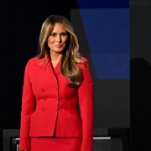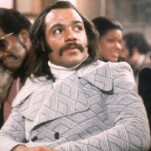“Episode Six”/“Boycott - Part 1”
In the opening installment of Twenty Twelve’s second season, Ian Fletcher twice defuses potentially explosive situations by turning to the analogy of “the center pole.” In Ian’s words, the Olympics (as well as London and all of Great Britain) are like a tent, and, depending on the circumstance, any number of concepts help keep that tent aloft: When Head of Sustainability Kay Hope is concerned that her efforts will soon be overshadowed by Head of Legacy Fiona Healey (even more so than “legacy” already overshadows “sustainability”), Ian assures his co-worker that hand driers and symbolic wind turbines are the center pole of the London games. Later, when a religiously motivated boycott threatens a domino effect that could topple everything he and his team have worked toward, Ian forgets all about sustainability and pitches his big tent with the help of his newly coined malapropism, “multiculturality.”
But what—or who—is the “center pole” of Twenty Twelve? As one season closes and another opens, the answer to that question becomes cloudy. For much of the first season, it appeared that the dynamic between the members of the Olympic Deliverance Commission would serve as the core of the show—but that theory is quickly discarded. There’s a moment in “Boycott – Part 1” where Ian mentions that the commission’s “family” will be growing with the addition of Fiona, but that line lands like a satirical jab at other workplace sitcoms. Modern television has conditioned viewers to see officemates like the members of the deliverance commission as parts of a surrogate family—but Twenty Twelve rarely portrays them as such. Though working toward a common goal, these characters each have personal agendas that don’t always generate storylines that can be shared. They’re compartmentalized, and while that helps the show dodge some TV-comedy clichés, it also limits the types of stories it can tell.
In short, it’s an emphasis on the political over the personal. (It’s also a necessity of the show’s short run; in a six-episode first season, there isn’t a lot of room to develop and foster relationships between the main characters.) Both the first-season finale and “Boycott – Part 1” hinge on conflicts initiated outside the deliverance commission’s walls. And while sacrifices and compromises must be made to solve those solutions, they have little effect on Ian or any member of his team: In order to save a rare type of beetle, Kay must commit to planting trees that will eventually be turned into stump habitats; the design flaw that inspired the boycott—the London Olympics’ “shared belief center” doesn’t face Mecca—could be solved by a small construction expenditure. You can’t make everyone happy—Tony Ward (Tim McInnerny), the filmmaker who takes to protesting the location of the games’ equestrian events, doesn’t get what he wants—though no one the deliverance commission makes concessions for ever includes the members of the commission.
The show is locating an emotional core within Ian and Sally’s relationship—though it goes through some typical will-they/won’t-they beats to arrive at that point. As far as the show is willing to portray, that’s still a one-way street of affection, as Sally’s overtures grow increasingly grand, a thoughtfulness Ian only recognizes when he unwraps a pair of new socks to go with a new tie and a some non-manure-stained trousers. Even Ian’s wife appears to perceive Sally’s true feelings before Ian, accusing her soon-to-be-estranged husband of shacking up with his assistant after he stormed out of the house a few nights prior. The dissolution of Ian’s marriage was telegraphed from the very beginning of the series, but it’s to John Morton’s credit that the writer-director has so far avoided pulling the trigger on taking the “un” off of Sally’s unrequited love. “Boycott – Part 1” goes so far as to introduce an additional obstacle to the consummation of those feelings, introducing Fiona as a near-ringer for Mrs. Fletcher—and thus the recipient of a cold shoulder from Sally. Of course, I’m justifying Sally’s disdain on a similarity in silhouettes, as Laura’s face is blurred-out (as are her address, license platter number, and the name of the street she and Ian lived on) and Ian’s too distracted by the threat of the Algerian boycott to really pay any attention to Fiona in their brief time together on screen.







































![Rob Reiner's son booked for murder amid homicide investigation [Updated]](https://img.pastemagazine.com/wp-content/avuploads/2025/12/15131025/MixCollage-15-Dec-2025-01-10-PM-9121.jpg)
